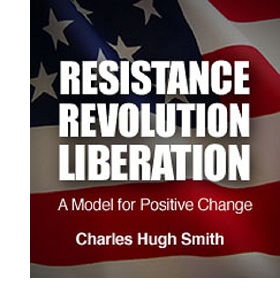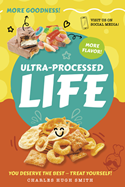Our choice is simple: either continue on the State-cartel path of complexity and rising costs that leads to a death spiral, or re-energize the forces of the market and community.
We are constantly told all our problems are too complex to be addressed with simple "big idea" solutions. Complex problems require complex solutions, we are assured, and so the "solutions" conjured by the Central State/Cartel Status Quo are so convoluted and complex (for example, the 2,319-page Dodd-Frank Wall Street Reform and Consumer Protection Act or the 2,074-page Obamacare bill) that legislators say they must "pass the bill to see what's in it." (What If We're Beyond Mere Policy Tweaks? February 6, 2012)
The real "solution" is to see that complexity itself is the roadblock to radical reformation of failed systems. Complexity is the subterfuge the Status Quo uses to erect simulacra "reforms" while further consolidating their power behind the artificial moat of complexity.
Over the next three days, I will present three "big idea" solutions that cut through the self-serving thicket of complexity. Nature is complex, but it operates according to a set of relatively simple rules. The interactions can be complex but the guiding principles can be, and indeed, must be, simple.
Big Idea One: Radically lower the cost basis of the entire U.S. economy. The cost basis of any activity is self-evident: what are the total costs of the production of a good or service? The surplus produced is the net profit which can be spent on consumption or invested in productive assets (or squandered in mal-investments).
We can understand surplus by way of simple examples. If it costs two barrels of oil to extract one barrel of oil from a well, there is no surplus at all to this activity; rather, it is a losing proposition. If it costs $100 to plow, plant, nurture and harvest $50 of crops, there is no surplus generated by this economic activity.
Anyone pursuing these kinds of zero-surplus activity will soon go broke and be eliminated from the financial "gene pool" of investors.
Central States and cartels by definition face no market forces on their cost basis.Central States (governments) have no competition and so there are no market pressures to contain costs. As a result, governments are intrinsically incapable of radically reducing the cost basis of their activity.
Cartels (the sickcare industry, the defense industry, etc.) by definition profit by fixing prices, not by adapting to competition, and so rising costs are simply shifted to consumers, with the aid of an over-regulating, moat-building "complex" Central State.
Unproductive layers of activity are essentially friction within the economy (
How Much of Our Economy Is Essentially Friction? September 20, 2011), and as with a machine, when the friction consumes all the surplus, the machine freezes up. Greece is an excellent example of this dynamic.
As I explain in
Resistance, Revolution, Liberation, there are three fundamental forces in society: the State, the market and community (i.e. the non-market social order).
As friction from the State and its crony-capitalist partners, the various cartels, inevitably rises, the surplus left to distribute via entitlements or invest shrinks.
The State has two mechanisms to counter this decline in surplus: it raises taxes on the productive enterprises and people, and redistributes that money to less productive dependents of the State via entitlements. Secondly, it prints money and redistributes the new cash.
Both are short-term expediencies that inevitably lead to collapse. Once taxes skim the economy's surplus for consumption, there is not enough left over to invest in productive assets that increase productivity. This triggers a death-spiral (positive feedback loop): as productivity stagnates, so does the surplus generated by economic activity. This leads to lower tax revenues, so the State raises taxes on the remaining productive elements, further bleeding the economy of funds that could be invested in future productivity gains.
Printing money debases the purchasing power of the existing currency, and over time this destroys the value of the currency and the wealth of those holding the currency. As people retreat to gold and land, the liquid capital necessary to invest in new ventures dries up, adding to the death-spiral described above.
In essence, the State and its cartels raise the cost basis of getting by from $10,000 to $40,000 by letting unproductive friction absorb all the economy's surplus. Layers of bureaucracy, paperwork and outright fraud consume roughly half of the funds spent on healthcare in the U.S.--not coincidentally, this aligns with the fact that the U.S. spends twice as much per person on sickcare compared to our developed-world competititors.(
The "Impossible" Healthcare Solution: Go Back to Cash July 29, 2009)
The State overcomes this by raising taxes on the productive and printing money.The State's "solution" isn't to reduce its own fiefdoms' spending or dismantle the high-friction cartels: it's to tax or print $30,000 and send this money to those making $10,000, so they can consume as much as those earning $40,000.
As noted above, consuming the nation's surplus in consumption and friction starves the nation of market-driven productive investment, which then leads to the death spirals of lower productivity and rising unproductive friction.
The only way to lower the actual cost basis of the economy is to reduce the role and power of the Central State, dismantle its favored cartels and re-empower community and the market forces of innovation and competition. The Central State and its cartels are incapable of innovation or reducing costs because they dominate the market and the community.
Community must play a central role in lowering the cost basis. The market cannot address all problems, though its ideological boosters wear blinders that demand allegiance to nothing but the market.
Community gardens are non-market social orders that enliven and empower communities and neighborhoods, yet their "market value" is negative: on a strictly cost basis, the food produced by agribusiness is cheaper on a kilocalorie/dollar basis than the food raised by community members in their garden. But this calculation is akin to reducing a human to a handful of ash and valuing that person at the market value of the calcium and other minerals in the ash.
Much of value in human life is beyond the market. Agribusiness would rather the State send money to people so they can sit at home "consuming" TV and media and then go out and buy highly profitable packaged food that sickens their bodies and spirits. That is the end result of an economy dominated by the State and cartels: a deeply and perniciously pathological society and economy.
Market forces in housing see the "solution" as wealthy Elites and corporations buying up all the housing and then renting it to recipients of State aid for high rents. Co-ops, co-housing and a host of other community housing solutions that radically lower the cost-basis of housing are rejected because they don't generate large profits. Their purpose is to lower the cost of housing while greatly enhancing its liveability and non-market value--"assets" that the market simply doesn't recognize unless they can be exploited for high profit margins.
This is why both the non-market forces of community and the market forces of efficiency and profit must share the economy if the cost basis is to be radically lowered. If people only make $10,000 in the market economy, the State's solution is to redistribute or print $30,000 so their consumption can equal that of people earning $40,000.
The solution I suggest is to radically lower the cost basis of the economy so those earning $10,000 can live simply and well on what they earn.
This solution does not compute for the Central State and its protected cartels, as they would lose their dominance over the economy. They have chosen the death-spiral for our future, and that's what we'll get until we restore some equilibrium between the State, the market and the non-market commmunity.
 Resistance, Revolution, Liberation: A Model for Positive Change (print $25)
Resistance, Revolution, Liberation: A Model for Positive Change (print $25)
(Kindle eBook $9.95)
We are like passengers on the Titanic ten minutes after its fatal encounter with the iceberg: though our financial system seems unsinkable, its reliance on debt and financialization has already doomed it.We cannot know when the Central State and financial system will destabilize, we only know they will destabilize. We cannot know which of the State’s fast-rising debts and obligations will be renounced; we only know they will be renounced in one fashion or another.
The process of the unsustainable collapsing and a new, more sustainable model emerging is called revolution, and it combines cultural, technological, financial and political elements in a dynamic flux.History is not fixed; it is in our hands. We cannot await a remote future transition to transform our lives. Revolution begins with our internal understanding and reaches fruition in our coherently directed daily actions in the lived-in world.
| Thank you, Chad W. ($10/mo), for your outrageously generous re-subscription to this site--I am greatly honored by your steadfast support and readership. |
 Resistance, Revolution, Liberation: A Model for Positive Change (print $25)
Resistance, Revolution, Liberation: A Model for Positive Change (print $25)

























